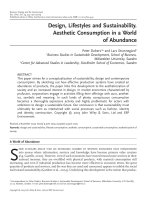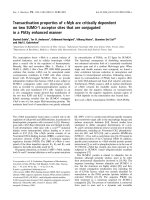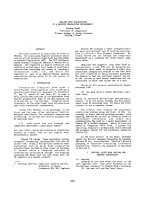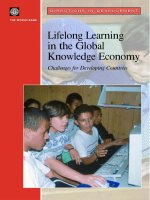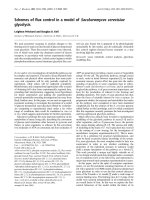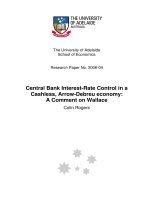Central Bank Interest-Rate Control in a Cashless, Arrow-Debreu economy: a comment on Wallace pptx
Bạn đang xem bản rút gọn của tài liệu. Xem và tải ngay bản đầy đủ của tài liệu tại đây (90.75 KB, 21 trang )
The University of Adelaide
School of Economics
Research Paper No. 2006-04
Central Bank Interest-Rate Control in a
Cashless, Arrow-Debreu economy:
A Comment on Wallace
Colin Rogers
1
Central Bank Interest-Rate Control in a Cashless, Arrow-Debreu economy: a
comment on Wallace
Colin Rogers
School of Economics
University of Adelaide
Abstract:
Wallace attempts to analyse central bank interest rate control in a cashless, Arrow-
Debreu economy. The model incorporates only the unit of account function of money
and exhibits a version of the classical dichotomy in which arbitrary accounting prices
are independent of the equilibrium real relative price vector. A model with these
properties is incapable of providing a theory of the price level or inflation, nominal
interest rate rules or justifying a role for the central bank. Nominal magnitudes are
nominal in name only and Wallace’s analysis is without theoretical foundations. It
generates a series of conceptual and logical puzzles.
First Draft Feb 2005.
Revised January 2006.
JEL classification:
Keywords: Cashless; Arrow-Debreu Economy: Accounting prices.
2
Central Bank Interest-Rate Control in a Cashless, Arrow-Debreu economy: a
comment on Wallace
Colin Rogers
School of Economics
University of Adelaide
I Introduction
In a recent paper Wallace (2004) uses a version of an Arrow-Debreu model to assess
the role of a central bank in setting nominal interest rates to stabilise the price level.
Wallace is of the opinion that the Arrow-Debreu model is the developed part of
economic theory while monetary theory is underdeveloped. Wallace’s intention is to
bring rigour to monetary economics.
In this note I point out the conceptual confusions that arise from proceeding as
Wallace suggests. The source of these confusions has been well documented in the
literature beginning with Hahn (1973a,b, 1980) but that has done little to prevent the
perpetuation of these counter intuitive results and conceptual errors as the papers by
Black (1970), Fama (1980), Woodford (1998) and now Wallace (2004) attest.
Wallace’s analysis is nevertheless important because it reveals in the simplest and
most transparent way what is wrong with so-called frictionless models of monetary
and fiscal theory. Frictionless models are well-specified Walrasian or Arrow-Debreu
models and they are frictionless precisely because they preclude any role for money.
That is, they are based only on the time-0 auction (explained below). It is nevertheless
claimed by their exponents that frictionless models can be applied to determine the
price level or analyse nominal interest rate rules employed by central banks to
3
stabilise inflation. This is precisely the task that Wallace sets himself but fails to
deliver.
The structure of the note is as follows. Part II outlines the properties of the Arrow-
Debreu model that render it incapable of dealing with monetary theory. Contrary to
Wallace, the Arrow-Debreu model is incapable of shedding any light on monetary
economics. Part III briefly outlines Wallace’s analysis of the role of a central bank in
a simple Arrow-Debreu model. Part IV outlines the conceptual confusions in
Wallace’s analysis. Part V concludes.
II Why money is irrelevant in an Arrow-Debreu economy
Frank Hahn (1982, p. 1, emphasis added) has been the most strident exponent of the
view that the Arrow-Debreu model has no role for money:
“The most serious challenge that the existence of money poses to the theorist is this:
the best developed model of the economy cannot find room for it. The best-developed
model is, of course, the Arrow-Debreu version of a Walrasian general equilibrium. A
world in which all conceivable contingent future contracts are possible neither needs
nor wants intrinsically worthless money. . The point is obvious and has been made
quite often. But it is doubtful that it has been fully taken on board.”
The properties of the Arrow-Debreu economy that render money irrelevant can best
be appreciated by considering what Ljungqvist and Sargent (2004, p. 208, p.213,
p.207) call time-0 trading in complete markets. I will call it the time-0 auction. In this
Arrow-Debreu model agents maximise lifetime utility subject to a single lifetime-time
budget constraint with prices expressed in terms of an abstract unit of account.
Underlying this single budget constraint is the idea that all multilateral trades are
possible because they are tracked by an unspecified clearing system (computer) that
monitors all net claims between traders. All the equilibrium trades are determined at
4
time 0 and subsequently the trades agreed at time 0 are executed but the model has
nothing to say about how this is done. One implication of the time-0 auction is that it
precludes any role for money because it eliminates the need for the functions of
money. The point is obvious because the unspecified clearing mechanism that lies
behind the time-0 auction acts as a substitute for the three traditional functions of
money: 1) medium of exchange, 2) store of value, and 3) unit of account.
The medium of exchange function is redundant because the auction generates the real
rates of exchange between all goods. Problems associated with real world barter, such
as the double coincidence of wants, do not arise in a time-0 auction so the medium of
exchange function of money is not required to solve them. In the real world money is
an innovation that reduces risk and increases the choice, trade and production sets of
agents. The Arrow- Debreu auction in a world of complete markets circumvents these
challenges of the real world obviating the need for money. Goods buy goods in a
time-0 auction – all three traditional functions of money are irrelevant in an Arrow-
Debreu model with complete markets.
The store of value function is redundant in a time-0 auction and any durable asset
dominates money in sequential trading versions of the auction. Strictly speaking the
unit of account function is also not required but obviously selecting a numeraire
would reduce the computations required even for the time-0 auction. The point is
simply that given the computing power underlying the auction the unit of account
function is not a necessary feature of the economy. Any commodity can act as the unit
of account even one with no physical existence, but jam is as good a numeraire as any
–the choice of numeraire is arbitrary. The conclusion is: none of the three traditional
functions of money is necessary in the Arrow-Debreu economy. The Arrow-Debreu
5
economy is a non-monetary economy. McCallum (1985, 2003) describes it as an
accounting system of exchange – a form of efficient or perfect barter not the
inefficient barter of the real world.
Employing a model of the Walrasian or Arrow-Debreu economy to rescue
underdeveloped monetary theory has in the past led to fundamental conceptual
confusions. For example, if the medium of exchange function is introduced, via a
cash-in-advance or in-arrears constraint, money appears to be a welfare reducing
innovation or a friction when history and common sense tells us that money was a
welfare enhancing innovation that helped to reduce the frictions of barter. For
example, when discussing the conceptual implications of the finance or cash-in-
advance constraint, Clower (1984, p. 257) concluded:
“…the choice alternatives confronting households were more restrictive in a money
than in a barter economy, which meant that monetary exchange is less efficient than
barter exchange, contrary to both common sense and two hundred years of
conventional wisdom. Something obviously was wrong. But what?”
What is wrong is that adding money, in this case the medium of exchange function, to
a model when it is not required leads only to counterintuitive results. Wallace’s
proposal to add unit of account endowments to the Arrow-Debreu model to explain
the role of a central bank in determining the price level is another example. The
simple fact is that appending some or all of the functions of money to the Arrow-
Debreu economy leads to counter intuitive results because the functions of money are
not required and if appended to the model are inessential additions in the sense of
Hahn (1973a, b). An inessential ‘monetary’ economy in the sense of Hahn (1973a, p.
230) is one where:
6
“… money is inessential in the sense that no monetary variable need enter into the
description, or determination, of that economy’s equilibrium.”
The Arrow-Debreu model is an inessential monetary economy in this sense. Monetary
variables play no role in the determination of equilibrium under the time-0 auction.
This is true also of inessential sequence versions of the model that are treated as
special cases of the complete markets versions of the model.
An important property of the inessential monetary economy can be highlighted with
reference to the history of monetary thought and Patinkin’s (1965, p. 15-17)
distinction between the different types of money and prices in Walrasian or Arrow-
Debreu models. Patinkin identified three types of prices in Walrasian models; money
prices which were quoted in terms of the medium of account, real relative prices
which are quoted in terms of commodities, the rate at which good X can be
transformed into good Y; and, accounting prices, the real relative prices quoted in
terms of a unit of account. These prices Patinkin called accounting prices and noted
that they were of no theoretical significance for the market. They are of no theoretical
significance for the market in the model because under the time-0 auction, for
example, agents only observe real relative prices. Accounting prices can be assigned
from the infinite set available so long as they are consistent with the equilibrium real
relative prices. So if the equilibrium real relative price of 1 unit of X is 2 units of Y
any accounting prices consistent with this ratio can be selected. Furthermore, although
a ‘price level’ can be defined in terms of accounting prices it has no theoretical
significance. The relevant economic theory, in this case the Arrow-Debreu model,
determines the equilibrium real relative prices but it has nothing to say about
accounting prices or the price level defined in terms of them. There is also no
7
economic theory to explain why stability of the price level is important. There is no
reason why in an Arrow-Debreu model any agent is interested in the general price
level and certainly there is no theory of what determines the price level defined in
terms of accounting prices.
As Wallace has only the unit of account function of money in his Arrow-Debreu
model its has the properties described above. Only accounting prices exist even
though there is said to be an endowment of this unit of account it is not employed as a
medium of exchange. There is in any event no economic theory in the Arrow-Debreu
model that can be used to shed any light on the behaviour of accounting prices.
Accounting prices should not be confused with money prices, which are prices quoted
in the medium of exchange. As the medium of exchange function does not exist in
Wallace’s Arrow-Debreu economy there are no money prices. Conflating money and
accounting prices only leads to confusion.
Wallace’s model makes this mistake and provides examples of the conceptual
confusions that arise when a role for money and monetary policy (central bank) is
introduced into an Arrow-Debreu economy where it is not required. The time-0
auction already allows a role for the unit of account and introducing an additional
agent – a central bank- to manage the unit of account is an inessential extension of the
model and generates a series of conceptual puzzles. To see this we first briefly outline
Wallace’s analysis.
III Wallace’s two-date model
Wallace begins by arguing that of the three traditional functions of money the Arrow-
Debreu model can accommodate the unit of account function (presumably the other
two functions are not necessary or cannot be accommodated). He argues that as the
8
nominal rate of interest can be anything in his model this provides scope for a central
bank (an outside agent) to set the rate of interest. By control of the interest rate the
central bank can then control prices and therefore inflation in his two-date model.
Also, he assumes that the unit-of-account is purely abstract –it has no physical
counterpart. All prices are quoted in ecus –an imaginary monetary unit - but there are
no notes or coins denominated in ecus. As we will see below, there must, however, be
some physical form of record keeping if individuals are to hold endowments of ecus
as postulated by Wallace. In Wallace’s model this function is not specified but is
presumably carried out by the auctioneer who runs the time-0 auction or by the central
bank. How these two agents are to interact is one of the puzzles of Wallace’s model.
The question to be addressed in part IV is whether this is a sensible model of a
cashless but nevertheless monetary economy.
Wallace begins with a simple 2-date pure-exchange economy with N people and L
goods at each date. Goods are indexed by } ,2,1{ Ll ∈ and people by
}, ,2,1{ Nn ∈ . Endowments of person n’s date-t commodities are denoted by
n
t
ω
and Wallace endows people with ecus accounts at each date so
n
t
e is person n’s
endowment of date-t ecus. The endowment of ecus can be negative or positive –a
negative endowment represents a debt. Person n’s end of date-t holdings of date-t
ecus is denoted by
n
t
x
1
. Wallace also assumes that all commodities and ecus are
perishable – they cannot be transferred between dates. Person n’s consumption vector
of date-t goods is denoted by
n
t
c and each person has a strictly increasing utility
1
It is not clear why agents would want to hold ecus if they are not used as the medium of exchange.
There is no reason why a medium of account need exist in a model that incorporates only a unit of
account.
9
function in consumption goods. There is no utility from the consumption of ecus. The
model is defined in real space. Wallace begins with Definition 1:
Definition 1: Person n can afford non negative ),,,(
2121
nnnn
xxcc at the prices
),,(
21
Rpp if:
0)()(
22222211111
≥−−++−−+
nnnnnnn
t
n
xcpepRxcpep
ωω
(1)
Wallace points out that Definition (1) requires the restriction
0≥
n
t
x because
n
t
x < 0
would imply that person n leaves date-t with a debt. But that is ruled out because ecus
are perishable and cannot be transferred between dates. The the nominal rate of
interest, i, is defined as
1
1
−=
R
i where R is the interest factor . Given definition 1
Wallace defines a competitive equilibrium (CE) as follows:
Definition 2: A CE is ),,,(
2121
nnnn
xxcc for each n and ),,(
21
Rpp such that (i)
),,,(
2121
nnnn
xxcc maximises
n
u subject to being affordable at ),,(
21
Rpp , and (ii) the
allocation is feasible; that is
∑∑
==
≤
N
n
n
t
N
n
n
t
c
11
ω
and
∑∑
==
≤
N
n
N
n
n
t
n
t
ex
11
for t = 1,2.
Wallace explicitly excludes equilibria in which date-1 and date-2 ecus are worthless
from the set of equilibria he wishes to consider. It is well known that fiat money has a
zero exchange value in equilibrium in the Arrow-Debreu model, Hahn (1965) and
Sargent (1987), but as Wallace has only a unit of account it is not clear what it means
to say that it is worthless.
Wallace also points out that in the absence of endowments of the unit of account the
above model is a simple special case of the standard pure exchange economy and it
has the standard zero-degree homogeneity property. He labels this
Claim 1. We will
return to this case below.
10
Wallace then goes on to present a proof of a claim about the properties of a CE under
definition 2 but does not explicitly address the question of existence.
Claim 2: In any definition 2 CE, (i) prices are positive ( ,0,
21
>> pp and R > 0) and
0≡
n
t
x and (ii) the feasibility conditions hold at equality and
∑
−
=
N
n
n
t
e
1
0
.
Wallace’s proof of claim 2 proceeds as follows (with some clarifying remarks
inserted):
Proof: Part (i) follows from the monotonicity of u. For part (ii) the monotonicity of u
implies non-satiety so the sum of (1) over n holds with equality. Because prices are
positive, the sum of (1) over n implies that the feasibility conditions hold at equality.
These are the feasibility conditions from definition (2);
∑∑
==
≤
N
n
n
t
N
n
n
t
c
11
ω
and
∑∑
==
≤
N
n
N
n
n
t
n
t
ex
11
. That and 0≡
n
t
x imply
∑
−
=
N
n
n
t
e
1
0
.
Wallace regards the conclusion that
∑
−
=
N
n
n
t
e
1
0
as reassuring as it means that claims on
date-t ecus are offset by debts of date-t ecus. As they are perishable, ecus cannot be
transferred across dates –they appear only as account entries as part of the
endowments each period.
Wallace also makes a
Claim 3 that subject to elimination of ecus distribution effects
the zero-degree homogeneity property continues to hold. There is an issue here
discussed by Hahn (1965) but it is not directly relevant to the subject of this paper,
which is the conceptual structure of Wallace’s model.
11
Wallace (2004, p. 3) then goes on to suggest that the zero-homogeneity postulate
means that there is a sense in which R can be selected arbitrarily. Furthermore:
“Such a selection can be interpreted as influencing the inflation rate between dates 1
and 2 because R has the units of date-1 ecus per date-2 ecus.”
Hence Wallace (2004, p. 4) proposes the introduction of a central bank to determine
the nominal rate of interest via its control over R. To do this he suggests that; “… we
think of a central bank as enforcing a particular magnitude for the nominal interest
rate is to have it offer to buy date-1 ecus for date-2 ecus, and vice versa. This would
seem to be the analogue of open market operations”.
To motivate a role for the central bank Wallace introduces it as agent 0. Agent 0 does
not deal in goods but chooses non-negative
0
1
x and
0
2
x subject to the special case of
definition (1):
0)(
0
2
0
2
0
1
0
1
=−+− xeRxe (2)
The term
00
tt
xe − is interpreted as the central bank’s sale (purchase if negative) of
date-t ecus. He then proceeds to argue that the only amendment needed to the
definition of a CE in an Arrow-Debreu model with a central bank is, “… to replace
the feasibility condition for ecus to include agent 0 (the central bank)”. He deduces
what the necessary condition is as follows.
“…. because (1) holds at equality for each agent and (2) holds, it follows that such
feasibility implies
∑∑
==
=
N
n
n
t
N
n
n
t
ex
00
for t =1, 2. And because 0=
n
t
x for 0≠n in any
CE, a necessary condition for a CE is
∑
=
=−
N
n
n
ttt
eex
1
00
for t =1, 2. (3)
12
Wallace (2004, p. 5) points out that when there is no central bank the necessary
condition for a CE with private endowments of ecus is
∑
−
=
N
n
n
t
e
1
0
and this condition
continues to hold in the presence of a central bank. Then, assuming that the central
bank has positive endowments of ecus, he claims to show that the central bank can
make an arbitrarily chosen R a necessary condition for a CE.
Claim 4. Assume
∑
−
=
N
n
n
t
e
1
0
and 0
0
>
t
e for t =1, 2. For any real
R
the central bank
(agent 0) can behave as a price taker in such a way that a necessary condition for a CE
is R =
R
.
Now as Wallace acknowledges, Claim 4 produces a puzzle because it requires the
central bank to hold positive balances of ecus when the private sector’s balances are
zero and for the central bank to act as a price taker. Neither of these claims stands up
to scrutiny.
First, if expression (3) is a necessary condition for a CE, and
∑
−
=
N
n
n
t
e
1
0
, then
0
00
=−
tt
ex and R can take any value in (2). But the central bank was introduced to
pin down the value of R (and i) and control inflation between the two dates. Second if
the central bank is to set the nominal rate of interest and determine R it cannot be a
price taker. It is the case that in the real world central banks exercise control over the
federal funds rate because the Fed is a monopoly supplier of money. A monopolist is
a price setter not a price taker so the equilibrium Wallace proposes cannot be
described as competitive in the sense that term is applied in the Arrow-Debreu model.
What has gone wrong? The simple answer is that these puzzles are another example
13
of the conceptual problems that arise when an attempt is made to introduce monetary
functions into a model where they are not required. In Wallace’s version of the
Arrow-Debreu model under a time-0 auction R is to an extent arbitrary because it is
defined in terms of accounting prices and accounting prices have no theoretical
content in the Arrow-Debreu model. The central bank can be introduced to define the
nominal rate of interest but, in the model, it might just as well define all the
accounting prices directly. In Wallace’s model the price level expressed in terms of
accounting prices can simply be defined in the same way as any other unit of
measurement like the foot or the metre. But of course such an economy is not a
monetary economy and models that suggest that conclusion generate conceptual
puzzles when applied to analyse monetary economies.
IV Interpreting Wallace’s model
Wallace’s model suffers from a range of conceptual and analytical puzzles some of
which are peculiar to his specification and others which reflect the properties of the
Arrow-Debreu model itself. The fundamental difficulty with attempts to introduce
money into the Arrow-Debreu model is that it is not needed. The time-0 auction
obviates any need for money because it eliminates the problems that the functions of
money solve in the real world –the problem of the double coincidence of wants, the
need for a store of value and a unit of account. Incorporation of any of these functions
into a model with a time-0 auction then amounts to the introduction of an inessential
component to the analysis.
The most obvious technical difficulty is recognised by Wallace when he realises that
the central bank cannot hold positive balances of ecus when the net private sector
balances are zero. If the former is a necessary condition for a CE then by (3) central
14
bank balances are also zero and expression (2) collapses. The central bank cannot buy
and sell date-1 ecus for date-2 ecus so as to tie down R and the rate of ‘inflation’. This
is hardly surprising. To control the nominal rate of interest, i.e. the interest factor R,
the central bank would have to be a monopoly supplier of ecus, which it is in reality,
but then it could not act as a price taker as required by
Claim 4. A price taker cannot
set the price of anything. Also, it is obvious that if the unit of account has no physical
existence and cannot act as the medium of exchange it cannot be traded by the central
bank or anyone else
2
. But the fundamental conceptual puzzle thrown up by Wallace’s
model is revealed by the interpretation of the concept of prices in the Arrow-Debreu
model.
Recall that, as Patinkin (1965, 1989) explained, general equilibrium models of the
Walrasian or Arrow-Debreu type have two types of prices if they exclude the medium
of exchange function of money. These are the real relative prices, the prices of
commodities in terms of each other, and accounting prices expressed in terms of some
designated unit of account (the latter may or may not have a physical existence). As
Wallace has only the unit of account function in his model he has only these two sets
of prices. There are no money or nominal prices or what Patinkin called ‘absolute
prices’ in Wallace’s model. Furthermore, as Patinkin explained, accounting prices are
to an extent arbitrary. So long as they are consistent with the equilibrium real relative
prices their values are of no analytical or theoretical significance. So if the real
2
The concept trading of date-1 ecus for date-2 ecus is problematic because Wallace (2004, p. 2) is
adamant that there is no technology that permits a person to convert ecus at one date into ecus at
another date. But presumably this technology is available to the central bank. In that case it can simply
set the price of date-1 ecus relative to date-2 ecus. But, of course, if a price setter exists that is not a
CE. It may then be thought that the nominal rate of interest can simply be set by the central bank as the
quantity of date-2 ecus required to repay a debt of 1 date-1 ecu. However, this is precisely the sort of
transaction that is ruled out by the absence of a technology that allows people to trade date-1 ecus for
date-2 ecus. Without a medium of exchange under the control of the central bank it cannot set the
nominal interest rate.
15
relative price of good X in terms of good Y is 2:1, i.e., it takes two units of good X to
acquire one unit of good Y, then any set of accounting prices in this ratio are
consistent with the equilibrium real relative prices. There is an infinite set of such
numbers and it is obvious that which one is selected is of no theoretical or analytical
significance as Patinkin pointed out. In the Arrow-Debreu model agents observe only
the real relative prices and the model determines the equilibrium real relative price
vector. Accounting prices are irrelevant to this process. Wallace’s model has this
property and he points to the arbitrary nature of the interest rate factor R and uses that
property of the model to justify a role for the central bank in setting the nominal
interest rate to determine the price level.
As R is defined in terms of what is called the nominal rate of interest in Wallace’s
model it is also a nominal variable. But recall that in a world where only the unit of
account function of money exists the term nominal does not mean money price but
accounting price. However, as accounting prices are to an extent arbitrary and of no
analytical or theoretical significance so are all the variables defined in terms of them
including the price level. This in turn means that the role of the central bank and
interest rate control in the cashless, Arrow-Debreu economy is of no analytical or
theoretical significance. What the central bank does in this world, assuming that it can
in fact set the ‘nominal’ interest rate, is set the accounting prices of all commodities
and the price level defined in terms of them. But this is of no analytical or theoretical
significance for the equilibrium real relative prices determined by the Arrow-Debreu
model. The whole exercise collapses one it is realised that in such a world inflation of
accounting prices is of no analytical interest. Inflation of accounting prices has no
16
impact of equilibrium real relative prices in the Arrow-Debreu model. The model
exhibits what Patinkin called the ‘invalid classical dichotomy’.
Examining the pure exchange version of the model reveals the inessential nature of
the accounting prices in Wallace’s analysis. The ‘nominal’ rate of interest continues
to exist in this state of the model because the accounting prices are still defined in
terms of ecus even when there are no ‘endowments’ of ecus. In that case, definition
(1) collapses to:
0)()(
22221111
≥−+−
nnnn
cppRcpp
ωω
(1’)
If we sum over the n markets we know from Walras’s Law that the terms in brackets
sum to zero for any price vector. (Consider a simple Edgeworth Box diagram for a
two-person two-good version of the model at each date). In that case R > 0 imposes
no restrictions on the equilibrium solution of the model generated by the time-0
auction. As Wallace (2004, p. 3) notes, there is therefore a sense in which R can be
selected arbitrarily. That is true because with only the unit of account function of
money the interest factor R can be arbitrarily set in this model so long as the unit of
account values are consistent with the real relative prices determined by the model. As
the model contains only the unit of account function of money only real relative and
accounting prices exist. Hence the ‘nominal’ rate of interest defined in terms of
accounting prices, not money prices, has no analytical or theoretical significance.
Attempting to introduce the central bank to determine the level of accounting prices is
then both trivial and without any theoretical significance. For if i and R are inessential
or irrelevant additions to the Arrow-Debreu model so is agent 0 –the central bank.
There is then nothing we can say about Wallace’s model with a central bank that
cannot be said using the pure exchange –moneyless -version.
17
The trivial nature of the analysis is further revealed once it is realised that there is no
sense in which inflation of accounting prices in the model can be compared with
inflation of money prices in the real world. In the model, agents observe only real
relative prices under the time-0 auction –accounting prices have no influence in the
model. By contrast, in the real world, agents observe only money prices and must
deduce from them what is happening to real relative prices. Also a general rise in
prices erodes the purchasing power of the medium of exchange so it is an important
piece of information. In the Arrow-Debreu model where there is no medium of
exchange and real relative prices are observed directly under the time-0 auction the
concept of a price level conveys no useful information.
V Concluding remarks
The conceptual confusions and contortions thrown up by Wallace’s Arrow-Debreu
economy with a central bank are symptomatic of an underlying conceptual flaw which
arises from the use of a model in which money is not required to examine the
properties of a monetary economy. The Arrow-Debreu model is a thought experiment
(a model) designed to isolate the conditions under which a general equilibrium
solution exists. From the perspective of monetary theory these conditions are seen to
be so restrictive as to render the model non-operational.
Wallace’s model is an example of the so-called frictionless model –the application of
the Arrow-Debreu model to monetary theory. The fundamental conceptual hurdles
that arises with the application of the model along the lines suggested by Wallace
arise because it is not a model of a monetary economy with a medium of exchange
and the concept of accounting prices it employs has no theoretical significance. There
18
is no theory of inflation or nominal interest rates rules that can be developed within an
Arrow-Debreu model as Wallace attempts. Inflation of accounting prices is an a
theoretical exercise of no relevance to the understanding of inflation of money prices
in the real world. This conclusion has significant implications for exponents of the
frictionless model, such as Woodford (2003) who attempt a more detailed extension
of what is essentially the model sketched by Wallace. The frictionless Arrow-Debreu
or Walrasian model cannot provide the foundation for monetary theory and policy.
19
References
Black, F. 1970. Banking and interest rates in a world without money, Journal of
Bank Research, autumn: 9-20.
Fama, E. 1980. Banking in the theory of finance, Journal of Monetary Economics,
6(1), 39-57.
Hahn, F. H. 1965. On some problems of proving the existence of an equilibrium in a
monetary economy, in The Theory of Interest Rates, ed. F. H. Hahn and F. P. R.
Brechling, London: Macmillam, 126-135.
Hahn, F. H. 1973a. On Transactions Costs, Inessential Sequence Economies and
Money, Review of Economic Studies, 40, 449-461.
Hahn, F. H. 1973b. On the foundations of monetary theory, in Essays in Modern
Economics, ed. By M. Parkin, 230-242, London: Longman.
Hahn, F. H. 1982. Money and inflation, Oxford: Basil Blackwell.
Ljungqvist, L, and Sargent T. J. 2004. Recursive macroeconomic theory, second
edition, Cambridge Mass. The M.I.T. Press.
McCallum B. 2003. Monetary Policy in Economies with Little or No Money,
Unpublished mimeo, Carnegie Mellon University.
Patinkin, D. 1965. Money Interest and Prices, (second edition), New York: Harper
and Row. Second edition, abridged (1989), Cambridge, Massachusetts, MIT Press.
20
Wallace, N. 2004. Central-Bank Interest-Rate Control in a Cashless, Arrow-Debreu
economy, unpublished paper, Pennsylvania State University.
Woodford, M. 1998. Doing without money: controlling inflation in a post-monetary
World, Review of Economic Dynamics, 1, 173-219, 1998.
